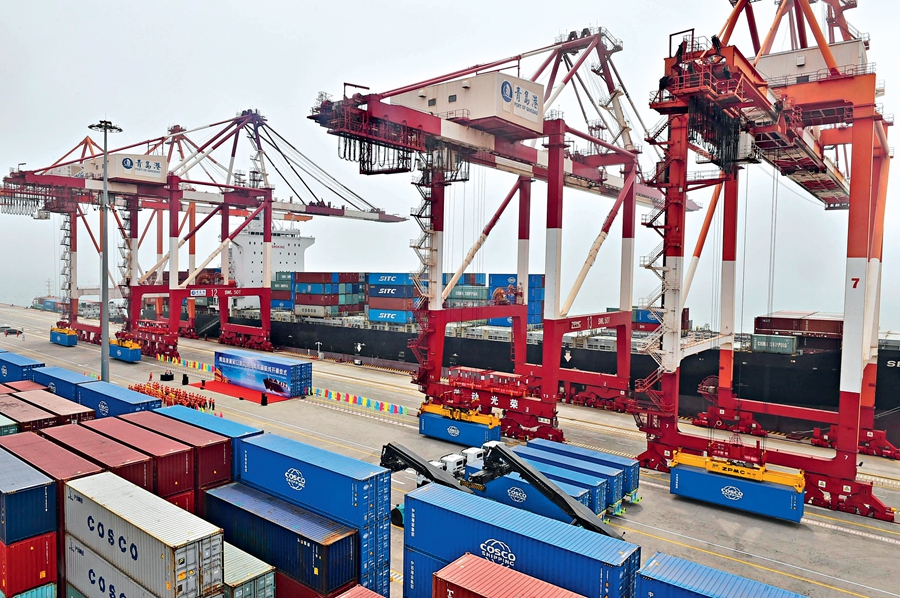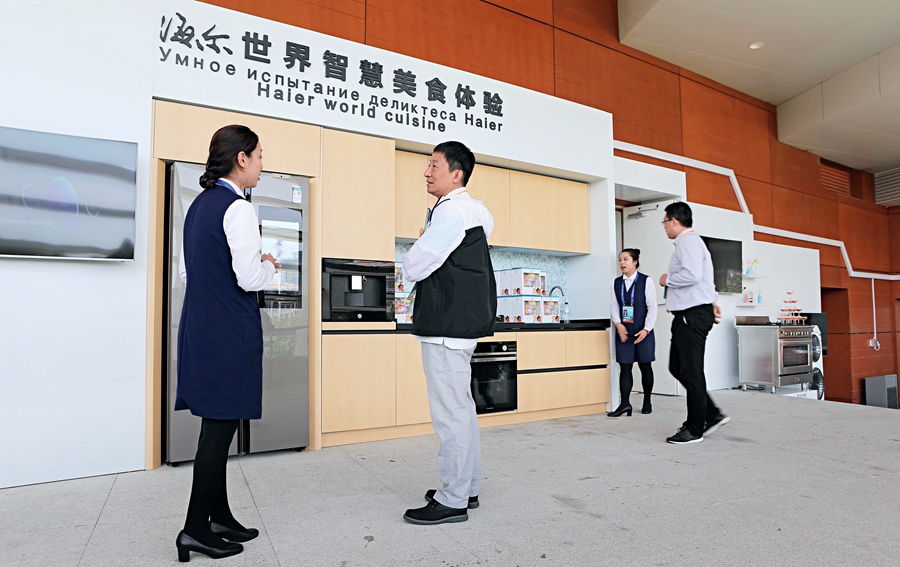SINCE its establishment 17 years ago, the Shanghai Cooperation Organization (SCO) has seen cooperation among its member states evolve and expand from security to a wider scope that includes security, economy, and people-to-people exchanges. The organization has shown great potential in maintaining regional peace and stability, seeking mutual development and prosperity, and promoting cultural exchanges and mutual learning, thus to significantly benefit peoples of all member nations.
Injecting New Impetus
During the 18th Meeting of the Council of Heads of Member States of the SCO from June 9 to 10, Chinese President Xi Jinping put forward a five-point proposal for the SCO, covering aspects such as unity and mutual trust, peace and security, development and prosperity, cultural and people-to-people exchanges, and international cooperation, among which “building a powerful engine to achieve common development and prosperity of the region” clearly indicated the direction of the SCO’s future development. President Xi said, “We should increase complementarity of our respective development strategies, continue to advance the Belt and Road Initiative under the principle of achieving shared growth through extensive consultation and collaboration, accelerate regional trade facilitation, and step up the implementation of the Agreement on International Road Transportation Facilitation and other cooperation documents.” He announced that China would set up a RMB 30 billion (US $4.7 billion) equivalent special lending facility within the framework of the SCO Inter-bank Consortium.

On May 29, 2018, the first foreign trade container route is formally put into operation at the Dongjiakou Harbor District of Qingdao Port.
Foreign reporters attending the SCO Qingdao Summit praised the importance of economic cooperation in safeguarding regional stability, saying that it not only boosts economic growth of the SCO member states and improves people’s living standards, but also promotes harmony among member nations and achieves balanced regional development.
Stelmakh Natallia, a reporter from Belarus told China Today, “As Belarusian President Lukashenko said, economic cooperation laid a solid foundation for SCO member states to seek common ground.”
By the end of May, 35 enterprises had already set up operations in the China-Belarus industrial park Great Stone, which included not only Chinese and Belarusian enterprises, but also those from Israel and Germany, as well as Chinese-foreign joint venture enterprises.
According to Belarusian Ambassador to China Kiryl Rudy, as 2018 is the China-Belarus Year of Tourism, the two sides took actions to promote economic and trade ties, as well as cultural and people-to-people exchanges, which included a visa-free entry policy for ordinary Chinese passport holders, and the development of new flight routes and tourist itineraries, to attract more Chinese visitors. This policy will benefit both business travelers and tourists.
Facilitating Trade
On June 10, Chinese State Councilor and Foreign Minister Wang Yi said the SCO Qingdao Summit has adopted multiple practical cooperation documents with great significance and wide coverage, involving numerous fields including trade facilitation, food security, and customs cooperation, which is conducive to further promoting in-depth and practical development of cooperation among various countries. In particular, the Summit announced a joint statement on promoting trade facilitation, which calls for the maintenance of the multilateral trade system with the rules of the World Trade Organization as its core and the building of an open world economy, thus sending out the unanimous voice of upholding multilateralism and opposing protectionism. More and more countries have realized that engaging in construction behind closed doors will not work, while coordinated development is a general trend.
Over the past 17 years, SCO member states have successively signed many documents, such as the Outline of Multilateral Economic and Trade Cooperation among SCO Member States and the Agreement on the International Road Transportation Facilitation, making progress in promoting regional economic integration, facilitating trade and investment, and boosting inter-connectivity.

Chinese and foreign reporters tour the Haier Kitchenware Experience Center during the SCO Qingdao Summit.
In 2001, the trade volume between China and other member states of SCO was only US $12.1 billion. However, from 2013 to 2017, China imported a staggering total of US $340 billion worth of products from other member states. Direct investment by Chinese companies in these countries reached nearly US $15 billion.
On June 15, 2017, with the raising of the national flags of India and Pakistan at the SCO secretariat, the organization carried out first expansion since its establishment. Currently the SCO member states cover an area of more than 60 percent of the Eurasian continent, accounting for nearly half of the world’s population, and over 20 percent of the world’s GDP. The SCO has become the world’s largest regional organization in terms of geographic coverage and population, providing a massive market for SCO member states.
“Without doubt, the development of the SCO will to a large extent determine the overall situation in Eurasia,” said SCO Secretary-General Rashid Alimov.
According to figures from Chinese customs, in the first five months of 2018, the imports and exports between China and the other seven SCO member states (Russia, India, Pakistan, Kazakhstan, Kyrgyzstan, Uzbekistan, and Tajikistan) grew rapidly, with the total volume hitting RMB 636.31 billion, a year-on-year increase of 10.3 percent, 1.5 percentage points higher than China’s overall foreign trade growth, among which RMB 413.09 billion were exports, with an increase of 6.5 percent over the same period of last year, and RMB 223.22 billion were imports, representing an increase of 18.2 percent.
Exploring Overseas Markets
Bolotskii Denis of Russia Today, a Russian international television network, was impressed after touring around the Haier Kitchenware Experience Hall in Qingdao. “In Russia, Haier’s refrigerators and air-conditioners are very popular. This time I had the opportunity to discover its kitchen appliances such as ovens. I believe they will also gain a larger market in the future.”
Established in 1984 in Qingdao, Haier Group has grown to become a world-renowned brand, becoming a window into China for foreign consumers.
Zhang Qingfu, vice president of Haier Overseas Electrical Appliances Industry Co., Ltd., said that Russia is an important country in the northern line of the Belt and Road and one of the countries with the largest market and the greatest potential. In 2008, Haier established the Haier Russia Refrigerator Factory – Haier’s first manufacturing factory in Russia. The operation of the Russian factory not only reduced costs and production time, but also facilitated the exploration of new markets in Central Asian countries such as Kazakhstan and Uzbekistan, as the distance between the producer and consumer in those countries has been shortened and the competitiveness of Haier’s products has been improved.
Citing Uzbekistan as an example, Zhang said in the past, products exported from Qingdao were usually transferred via Russia, so transportation alone took one month and the cost was high. After establishment of the Russia factory, the transportation period was shortened to one week with cost being reduced and the competitiveness of products increasing by 15 percent. In 2017, Haier became the fastest growing brand in Russia and secured a 48 percent share of the entire Russian high-end multi-door refrigerator market. It also took a 12 percent share of the household air conditioners market, achieving the No.1 market occupancy rate. On May 28, 2018, the founding ceremony for Haier’s industrial park and washing machine production base was held in Russia, which is expected to launch production in July 2019, with their products to be sold to Russian, Central Asian, and European markets.
Khan Abdul Wajid, a reporter from Independent News Pakistan, said that in his country, Haier is a household name. “Nearly all Pakistani families use a Haier product. Compared to European and American brands, Haier offers quality products at affordable prices. Also I noticed that Chinese enterprises take social responsibilities in improving education and reducing poverty and I would like to cover stories in this regard,” he said.
The GDP of SCO members takes up almost one quarter of the world’s total, and member states jointly make up the largest regional market on the Eurasian continent. In 2017, trade between China and other SCO member countries exceeded US $200 billion.
Closer ties in economy and trade accelerate the prosperity of all nations’ markets and forms a pattern of mutual benefit. For example, natural gas from Central Asia is used by Chinese families; Russian timber is made into furniture in China; Cotton yarns from Pakistan and Uzbekistan are spun and weaved into clothes for sale in China. Most automobiles, power station grids, and cellphones used in other SCO member countries are made in China.
“As China promotes economic cooperation among all the SCO member states within the framework of Belt and Road Initiative, the economic cooperation will be enhanced with highly interlinked benefits, eventually forming a community with shared interests,” said China’s former ambassador to Uzbekistan Gao Yusheng.

